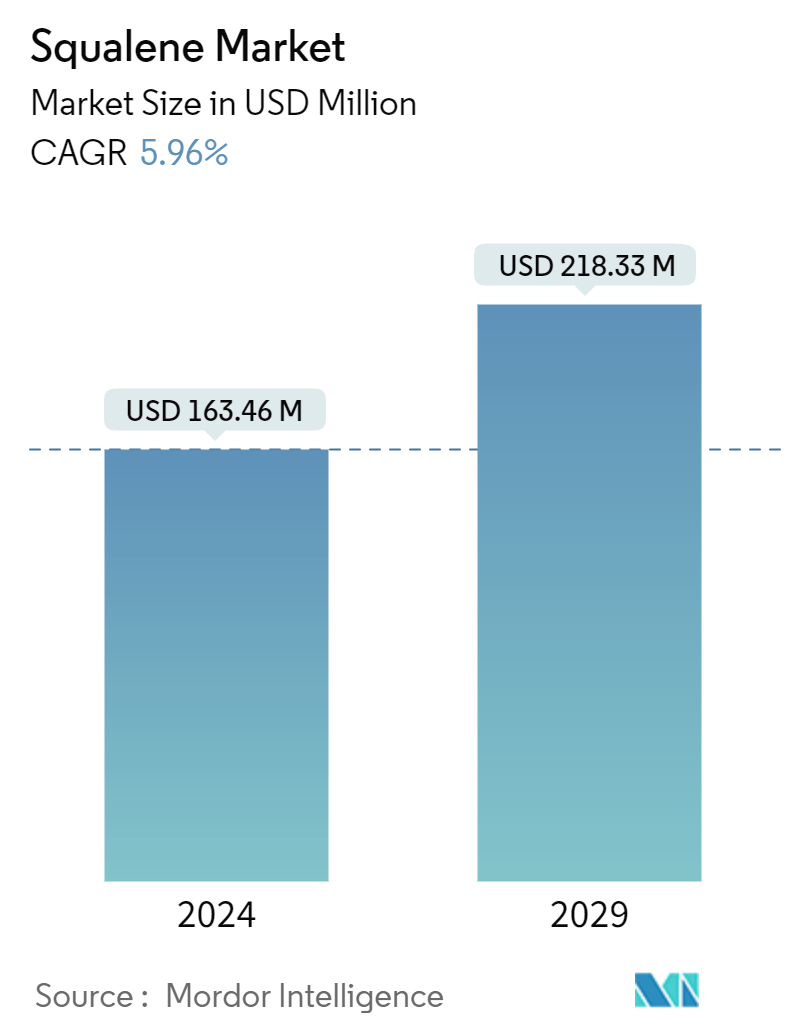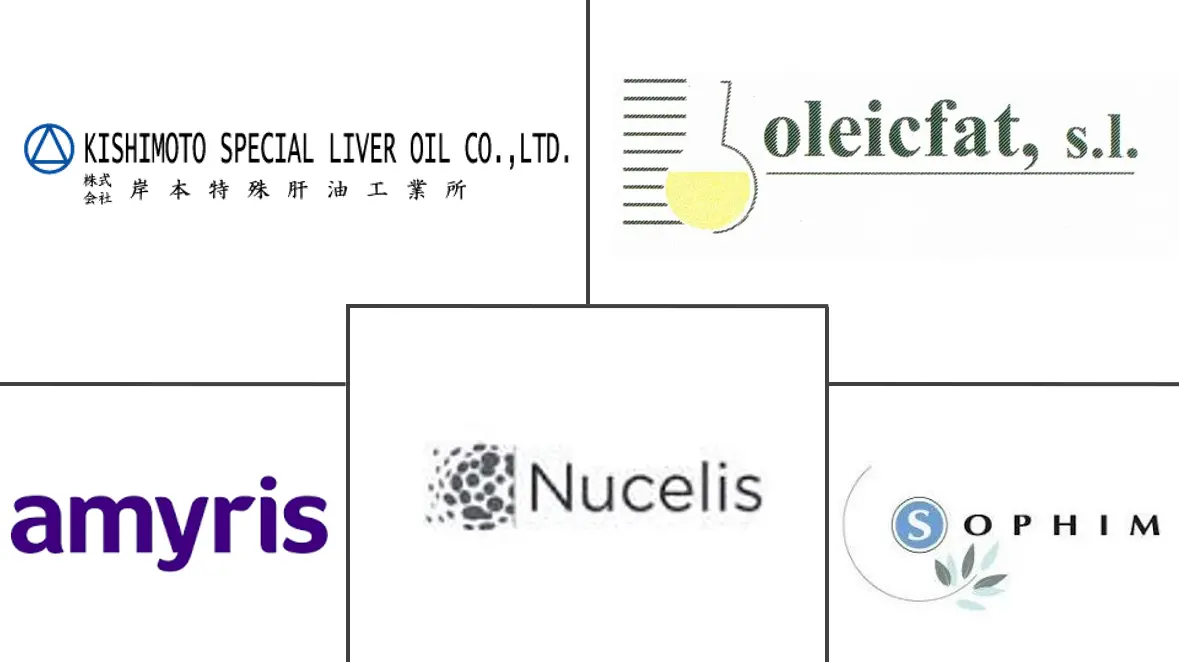Market Size of Squalene Industry

| Study Period | 2019 - 2029 |
| Market Size (2024) | USD 163.46 Million |
| Market Size (2029) | USD 218.33 Million |
| CAGR (2024 - 2029) | 5.96 % |
| Fastest Growing Market | Asia Pacific |
| Largest Market | Europe |
Major Players
*Disclaimer: Major Players sorted in no particular order |
Squalene Market Analysis
The Squalene Market size is estimated at USD 163.46 million in 2024, and is expected to reach USD 218.33 million by 2029, growing at a CAGR of 5.96% during the forecast period (2024-2029).
- The growing demand for squalene from the cosmetics sector and pharmaceutical industry is the major factor driving the demand for the market studied.
- However, concerns about shark killing and limitations are likely to restrain the market’s growth.
- Nevertheless, the research and development on squalene for oncology uses is expected to create new opportunities for the market in the coming years.
- Europe accounted for the highest market share and is likely to dominate the market during the forecast period.
Squalene Industry Segmentation
Squalene, a colorless and odorless organic compound, is commercially extracted from shark liver oil and is non-toxic. Due to its non-toxic nature, squalene has extensive applications in personal care. In the cosmetics industry, squalene oil combats free radicals, which are known to damage the skin and accelerate aging. Furthermore, squalene serves as an ingredient in adjuvants for various vaccines, such as those for influenza and COVID-19, boosting their efficacy.
The squalene market is segmented by source, end-user industry, and geography. By source, the market is segmented into animal source, vegetable source, biosynthetic, and other sources. By end-user industry, the market is segmented into cosmetics, food, pharmaceuticals, and other end-user industries. The report also covers the market size and forecasts for the squalene market in 27 countries across major regions. For each segment, the market size and forecasts are provided on the basis of value (USD).
| By Source | |
| Animal Source | |
| Vegetable Source | |
| Biosynthetic | |
| Other Sources |
| By End-user Industry | |
| Cosmetics | |
| Food | |
| Pharmaceuticals | |
| Other End-user Industries |
| By Geography | |||||||||||
| |||||||||||
| |||||||||||
| |||||||||||
| |||||||||||
|
Squalene Market Size Summary
The squalene market is poised for significant growth over the forecast period, driven by its increasing application in the cosmetics and nutraceutical industries. Squalene is a key ingredient in high-end skincare products, known for its moisturizing and rejuvenating properties, making it a popular choice in anti-aging products and various cosmetics. The global cosmetics market, particularly in regions like Europe, continues to thrive, with consumers increasingly favoring natural and ingredient-based products. This trend is further bolstered by the aging population's demand for anti-aging solutions. Despite challenges such as concerns over shark killing and limitations in sourcing, the market is expected to benefit from ongoing research and development, particularly in oncology applications, presenting new opportunities for growth.
Europe stands out as the dominant region in the squalene market, supported by its well-established cosmetic and pharmaceutical industries. Countries like Germany and the United Kingdom are key players, with robust demand from the cosmetic and personal care sectors. The region's market is further strengthened by the presence of major industry players and a growing interest in dietary supplements. The market's consolidated nature, with leading companies like Amyris, Inc. and Sophim, continues to shape its landscape. Recent developments, such as the introduction of non-animal-derived squalene and partnerships for biotechnology-derived squalene, highlight the industry's commitment to sustainable and innovative solutions, ensuring a steady supply to meet the rising demand.
Squalene Market Size - Table of Contents
-
1. MARKET DYNAMICS
-
1.1 Market Drivers
-
1.1.1 Growing Demand from Cosmetics Sector
-
1.1.2 Rising Demand from the Pharmaceutical Industry
-
1.1.3 Other Drivers
-
-
1.2 Market Restraints
-
1.2.1 Shark Killing Concerns and Limitations
-
1.2.2 Other Restraints
-
-
1.3 Industry Value Chain Analysis
-
1.4 Porter's Five Forces Analysis
-
1.4.1 Bargaining Power of Suppliers
-
1.4.2 Bargaining Power of Buyers
-
1.4.3 Threat of New Entrants
-
1.4.4 Threat of Substitute Products and Services
-
1.4.5 Degree of Competition
-
-
-
2. MARKET SEGMENTATION (Market Size in Value)
-
2.1 By Source
-
2.1.1 Animal Source
-
2.1.2 Vegetable Source
-
2.1.3 Biosynthetic
-
2.1.4 Other Sources
-
-
2.2 By End-user Industry
-
2.2.1 Cosmetics
-
2.2.2 Food
-
2.2.3 Pharmaceuticals
-
2.2.4 Other End-user Industries
-
-
2.3 By Geography
-
2.3.1 Asia-Pacific
-
2.3.1.1 China
-
2.3.1.2 India
-
2.3.1.3 Japan
-
2.3.1.4 South Korea
-
2.3.1.5 Malaysia
-
2.3.1.6 Thailand
-
2.3.1.7 Indonesia
-
2.3.1.8 Vietnam
-
2.3.1.9 Rest of Asia-Pacific
-
-
2.3.2 North America
-
2.3.2.1 United States
-
2.3.2.2 Canada
-
2.3.2.3 Mexico
-
-
2.3.3 Europe
-
2.3.3.1 Germany
-
2.3.3.2 United Kingdom
-
2.3.3.3 France
-
2.3.3.4 Italy
-
2.3.3.5 Spain
-
2.3.3.6 NORDIC Countries
-
2.3.3.7 Turkey
-
2.3.3.8 Russia
-
2.3.3.9 Rest of Europe
-
-
2.3.4 South America
-
2.3.4.1 Brazil
-
2.3.4.2 Argentina
-
2.3.4.3 Colombia
-
2.3.4.4 Rest of South America
-
-
2.3.5 Middle East and Africa
-
2.3.5.1 Saudi Arabia
-
2.3.5.2 Qatar
-
2.3.5.3 United Arab Emirates
-
2.3.5.4 Nigeria
-
2.3.5.5 Egypt
-
2.3.5.6 South Africa
-
2.3.5.7 Rest of Middle East and Africa
-
-
-
Squalene Market Size FAQs
How big is the Squalene Market?
The Squalene Market size is expected to reach USD 163.46 million in 2024 and grow at a CAGR of 5.96% to reach USD 218.33 million by 2029.
What is the current Squalene Market size?
In 2024, the Squalene Market size is expected to reach USD 163.46 million.

